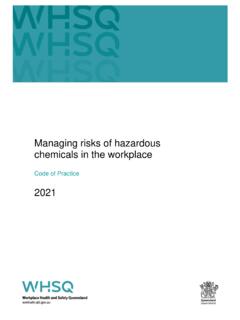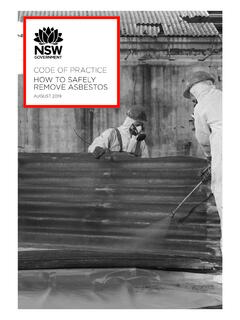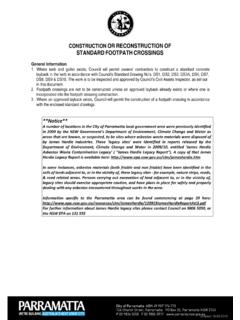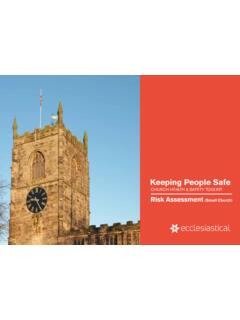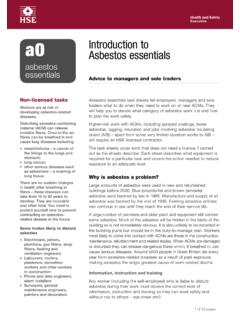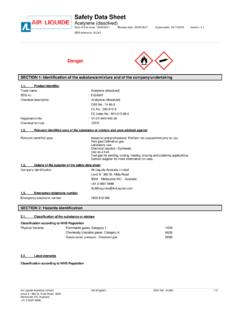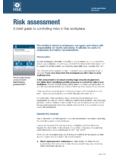Transcription of Respiratory Protection - Occupational Safety and Health ...
1 Respiratory Protection The Occupational Safety and Health Administration (OSHA) construction industry regulations relating to Respiratory Protection (29 CFR ) are actually found under the general industry regulations applicable to Respiratory Protection in 29 CFR Those provisions mandate Respiratory Protection if engineering controls are not feasible or are ineffective. OSHA requires methods such as substituting less toxic materials or ventilating the work area to prevent atmospheric contamination. When engineering controls fail to reduce employee exposures to harmful contaminants below the permissible exposure limit (PEL) of a contaminant, Respiratory Protection and accompanying program elements must be put in place.
2 Written Respiratory Protection Program The OSHA Respiratory standard requires contractors to develop and implement a written Respiratory Protection program for situations in which PELs of airborne contaminants could be exceeded or when the employer requires use of respirators by workers. See also the chapter on Confined Spaces. The written program also must address voluntary respirator use; respirator selection; medical evaluations; fit-testing; use of respirators; user seal checks;. maintenance and care of respirators; identification of filters, cartridges and canisters; employee training; and program evaluation.
3 The standard requires the Respiratory program to be administered by a program administrator and updated to reflect the changing workplace conditions that affect respirator use. The standard sets out several mandatory components within the aforementioned program categories including fit testing, seal-check and cleaning procedures in addition to a medical evaluation questionnaire and voluntary-use procedures that are compiled in appendices to Many of the elements listed may not need to change for each project. For example, medical evaluations, fit-test procedures, schedules and procedures for maintaining respirators, air-quality requirements for supplied-air respirators, employee training and program evaluations often can remain consistent.
4 The only change that may be needed in a work-site specific written program is the procedure for respirator selection. (The procedures for respirator selection are addressed later in this chapter.). When employees voluntarily wear Respiratory Protection , the employer still must establish and implement written Respiratory program components related to the medical evaluation of a worker's ability to wear the respirator safely . Elements relating to cleaning, storing and maintaining respirators must be addressed, as well. Employees must be provided with copies of the information contained in Appendix D of the standard titled Information for Employees Using Respirators When Not Required Under the Standard.
5 When filtering face pieces (dust masks) are worn voluntarily, employees only must be given the Appendix D. information; however, when filtering face pieces are required by a contractor, the entire Respiratory Protection standard applies that is, medical evaluation, fit testing and other components of a written Respiratory program must be in place. Although OSHA does not require specific training or qualifications for the program administrator, this person must know the standard and have enough experience or training to be able to enforce the written program and conduct evaluations of the program's effectiveness.
6 Respirator Selection The standard requires that the correct Respiratory Protection be selected to provide adequate Protection against airborne hazards and that only respirators certified by the National Institute for Occupational Safety and Health (NIOSH) be used. Contractors are required to evaluate the Respiratory hazards in their workplaces to determine the identity of contaminants, chemical states and physical forms. If an employer cannot identify or reasonably estimate employee exposures to Respiratory hazards, the employer must consider the atmosphere Immediately Dangerous to Life or Health (IDLH).
7 IDLH atmospheres require a full-face piece, pressure demand self-contained breathing apparatus (SCBA) or supplied-air respirator (SAR) with self-contained auxiliary air supply. Under most circumstances in roofing where Respiratory hazards have been evaluated, SCBAs and SARs are not needed other respirators described here will be adequate. An exception may be when employees need to enter a confined space, such as a tanker, because an oxygen-deficient atmosphere and other Respiratory hazards may exist. See the NRCA Safety Manual chapter on confined space.
8 Respirator Selection Hazard Assessment Hazard assessments must be conducted to select the appropriate respirators for particular environmental conditions. A contractor should begin the hazard assessment by obtaining information from the material Safety data sheets (MSDSs) supplied by product manufacturers. The MSDSs provide Health hazard information, the nature of the chemicals in the product, the PEL and other valuable information. To quantify the airborne concentration of a contaminant, air samples must be collected, and subsequent testing of samples will aid in selecting the type of respirator that is needed, if any.
9 Two methods of determining whether gas or organic vapor contaminants are present are through passive monitoring badges and colorimetric tubes. Colorimetric tubes, which are available through most Safety supply companies, provide the user with an instantaneous reading. These readings, however, can be inaccurate. The passive monitor badges are a good alternative for organic vapor detection and are more accurate, but they do not provide an instant reading and must be sent to a lab for analysis. Air-sampling pumps are capable of detecting airborne contaminants such as asbestos fibers or silica particles along with toxic gases or harmful vapors.
10 Industrial hygiene firms or environmental test labs often are best-suited for analyzing results from air sampling and providing solutions for particular exposures. After a hazard assessment has been completed, OSHA requires employers to implement one of the following methods, ranked by order of preference, to reduce employee exposures: 1. Engineering controls 2. Administrative/work practice controls 3. Personal protective equipment (PPE), such as respirators An example of an engineering control is installation of a ventilation system which may work well in shops or manufacturing plants but are impractical in the construction industry.










